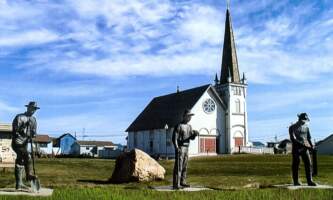It’s hard to miss Old St. Joe’s. With its Gothic architecture, the white building perched on the edge of Anvil City Square dominates the skyline of Nome just like it did back in the early 1900s.
Old St. Joe’s is listed on the National Register of Historic Places not only for its age and architecture, but for the role it played during Nome’s early history. Avoiding the fate of many other gold rush era buildings, which were destroyed by fire or flood, the story of Old St. Joe’s parallels that of the Alaskan pioneer spirit: one of hard work, resourcefulness and a deep respect for the past.
Construction
In July 1901, the cornerstone of St. Joseph’s was laid by Jesuit priest Fr. Aloysius Jacquet, who had come to Nome to build a church for the community of Catholics living there. Fr. Jacquet worked feverishly to finish his task before hard winter set in, but began showing signs of erratic behavior. By November, he was declared insane, just as his endeavor was nearing completion. Fr. Jacquet was taken 600 miles by dog sled to the mission at Holy Cross for treatment. Even that didn’t help, so he was held in jail at St. Michael until the spring thaw, when he left Alaska for good.
Reports from that time indicate that Fr. Jacquet did eventually recover, and his efforts in Alaska resulted in a building that is not only a lasting historic landmark, but that likely even saved lives.
A beacon in the darkness
St. Joseph’s served the parishioners and the community for decades. An 8 by 6-foot brightly-lit cross on the steeple was a welcome landmark for travelers, especially during poor weather and blizzards. It towered 88 feet into the air and could be seen for miles during the long, dark winters. The cross turned out to be such an important navigational aide – with 7 lights on the Bering Sea side and 3 lights on the tundra side – that miners, mushers and the community all contributed to the cost of keeping it lit throughout the winter months.
Repurposing
When St. Joe’s was built, Nome had a population of 12,000. That number dipped dramatically after the gold rush, and the church was too costly to operate except for special occasions. It also
needed regular upkeep. By the mid-forties, the landmark steeple become detached and was removed for safety reasons. Soon after, St. Joe’s was sold to a mining company, moved a block, and used for a warehouse.
A community comes together
After decades of use, the mining company planned to demolish St. Joe’s unless another use could be made of it. Residents recognized the importance of the building as an historic landmark and came together with a plan. In 1995 old St. Joe’s was donated to the city, which later moved it to a spot on Anvil City Square and renovated the building to its original Gothic design. Today Old St. Joe’s serves as a hall for community events. Historic photos line the walls, with a large portrait of the “Three Lucky Swedes” holding court over what once was the sanctuary of the church. Concerts such as the annual Christmas Extravaganza, the commencement ceremony for UAF’s Northwest campus, and the Iditarod Arts and Crafts Fair and Fine Arts Show are traditionally held at “Old St. Joe’s.”
Visiting Old St. Joe’s
Today Old St. Joe’s is the only example of early Gothic architecture built of wood in Alaska. From the exterior, you can see the steep, gabled roof, finials, buttresses and pointed glass windows. Old St. Joe’s is open frequently for community events, but does not have regular hours. When you get to town, ask about upcoming events at the Visitors Center.


